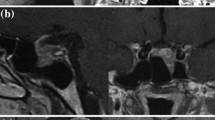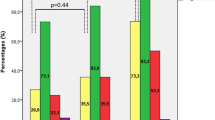Abstract
Purpose
Growth hormone-secreting pituitary adenomas (GH-PAs) with a low Knosp grade are typically associated with a good postoperative biochemical remission (BR) rate. However, a proportion of patients do not achieve remission. In this study, we aimed to investigate predictive factors of postoperative remission for lower Knosp GH-PAs.
Methods
In this retrospective study, we enrolled 140 patients who were diagnosed with lower Knosp (0–2) GH-PAs and received trans-sphenoidal surgery between December 2016 and June 2021 from the largest pituitary tumor surgery center in southern China. The univariate, binary Logistic regression, and receiver operating characteristic curve (ROC) analyses were employed to determine independent predictors and cutoff values of remission. The postoperative outcome was defined as remission using the 2010 consensus criteria of acromegaly.
Results
One hundred and thirty six patients (97.1%) achieved gross total resection. The postoperative long-term BR was 68.6%. Empty sella, tumor maximum diameter and postoperative GH levels were independent factors predicting remission. ROC revealed that postoperative 24 h GH ≤ 1.3 ng/mL and ≤ 1.23 ng/mL were valuable predictors for 3-month and long-term remission respectively, and that postoperative 3-month GH ≤ 1.6 ng/mL and tumor maximum diameter ≤ 17 mm were predictors for delayed remission.
Conclusion
Early postoperative GH levels can be used as predictors of remission. However, BR was not associated with preoperative somatostatin analogs therapy or Knosp grade (0–2). For patients without residual tumor or recurrence and whose GH levels are slightly elevated within 1 year after surgery, adjuvant treatments may not be necessary.



Similar content being viewed by others
Data availability
Data are available upon request.
References
Giustina A, Chanson P, Bronstein MD, Klibanski A, Lamberts S, Casanueva FF et al (2010) A Consensus on criteria for cure of acromegaly. J Clin Endocr Metab 95(7):3141–3148. https://doi.org/10.1210/jc.2009-2670
Giustina A, Chanson P, Kleinberg D, Bronstein MD, Clemmons DR, Klibanski A et al (2014) Expert consensus document: a consensus on the medical treatment of acromegaly. Nat Rev Endocrinol 10(4):243–248. https://doi.org/10.1038/nrendo.2014.21
Nomikos P, Buchfelder M, Fahlbusch R (2005) The outcome of surgery in 668 patients with acromegaly using current criteria of biochemical ‘cure’. Eur J Endocrinol 152(3):379–387. https://doi.org/10.1530/eje.1.01863
Phan K, Xu J, Reddy R, Kalakoti P, Nanda A, Fairhall J (2017) Endoscopic endonasal versus microsurgical transsphenoidal approach for growth hormone-secreting pituitary adenomas-systematic review and meta-analysis. World Neurosurg 97:398–406. https://doi.org/10.1016/j.wneu.2016.10.029
Asha MJ, Takami H, Velasquez C, Oswari S, Almeida JP, Zadeh G et al (2020) Long-term outcomes of transsphenoidal surgery for management of growth hormone-secreting adenomas: single-center results. J Neurosurg 133(5):1360–1370. https://doi.org/10.3171/2019.6.Jns191187
Taghvaei M, Sadrehosseini SM, Ardakani JB, Nakhjavani M, Zeinalizadeh M (2018) Endoscopic endonasal approach to the growth hormone-secreting pituitary adenomas: endocrinologic outcome in 68 patients. World Neurosurg 117:e259–e268. https://doi.org/10.1016/j.wneu.2018.06.009
Micko AS, Wohrer A, Wolfsberger S, Knosp E (2015) Invasion of the cavernous sinus space in pituitary adenomas: endoscopic verification and its correlation with an MRI-based classification. J Neurosurg 122(4):803–811. https://doi.org/10.3171/2014.12.JNS141083
Park HH, Kim EH, Ku CR, Lee EJ, Kim SH (2018) Outcomes of aggressive surgical resection in growth hormone-secreting pituitary adenomas with cavernous sinus invasion. World Neurosurg 117:e280–e289. https://doi.org/10.1016/j.wneu.2018.06.012
Katznelson L, Laws ER Jr, Melmed S, Molitch ME, Murad MH, Utz A et al (2014) Acromegaly: an endocrine society clinical practice guideline. J Clin Endocrinol Metab 99(11):3933–3951. https://doi.org/10.1210/jc.2014-2700
Zhang S, Li Y, Guo X, Gao L, Lian W, Yao Y et al (2018) Body mass index and insulin-like growth factor 1 as risk factors for discordant growth hormone and insulin-like growth factor 1 levels following pituitary surgery in acromegaly. J Formos Med Assoc 117(1):34–41. https://doi.org/10.1016/j.jfma.2017.02.014
Hardy J, Vezina JL (1976) Transsphenoidal neurosurgery of intracranial neoplasm. Adv Neurol 15:261–273
Shou X, Shen M, Zhang Q, Zhang Y, He W, Ma Z et al (2016) Endoscopic endonasal pituitary adenomas surgery: the surgical experience of 178 consecutive patients and learning curve of two neurosurgeons. BMC Neurol 16(1):247–254. https://doi.org/10.1186/s12883-016-0767-0
Truong HQ, Lieber S, Najera E, Alves-Belo JT, Gardner PA, Fernandez-Miranda JC (2018) The medial wall of the cavernous sinus. Part 1: surgical anatomy, ligaments, and surgical technique for its mobilization and/or resection. J Neurosurg 131(1):122–130. https://doi.org/10.3171/2018.3.JNS18596
Goncalves MB, de Oliveira JG, Williams HA, Alvarenga RM, Landeiro JA (2012) Cavernous sinus medial wall: dural or fibrous layer? Systematic review of the literature. Neurosurg Rev 35(2):147–154. https://doi.org/10.1007/s10143-011-0360-3
Wang Z, Guo X, Gao L, Feng C, Lian W, Deng K et al (2019) Delayed remission of growth hormone-secreting pituitary adenoma after transsphenoidal adenectomy. World Neurosurg 122:e1137–e1145. https://doi.org/10.1016/j.wneu.2018.11.004
Shin MS, Yu JH, Choi JH, Jung CH, Hwang JY, Cho YH et al (2013) Long-term changes in serum IGF-1 levels after successful surgical treatment of growth hormone-secreting pituitary adenoma. Neurosurgery 73(3):473–479. https://doi.org/10.1227/01.neu.0000431480.87160.84
Zahr R, Fleseriu M (2018) Updates in diagnosis and treatment of acromegaly. Eur Endocrinol 14(2):57–61. https://doi.org/10.17925/EE.2018.14.2.57
Shen M, Tang Y, Shou X, Wang M, Zhang Q, Qiao N et al (2018) Surgical results and predictors of initial and delayed remission for growth hormone-secreting pituitary adenomas using the 2010 consensus criteria in 162 patients from a single center. World Neurosurg 124:e39–e50. https://doi.org/10.1016/j.wneu.2018.11.179
Coopmans EC, Postma MR, Wolters TLC, van Meyel SWF, Netea-Maier R, van Beek AP et al (2021) Predictors for remission after transsphenoidal surgery in acromegaly: a dutch multicenter study. J Clin Endocr Metab 106(6):1783–1792. https://doi.org/10.1210/clinem/dgab069
Yao S, Chen WL, Tavakol S, Akter F, Catalino MP, Guo X et al (2021) Predictors of postoperative biochemical remission in acromegaly. J Neurooncol 151(2):313–324. https://doi.org/10.1007/s11060-020-03669-4
Huan C, Cui G, Lu C, Qu X, Han T (2015) Role of Ki-67 in acromegalic patients with hyperprolactinemia: retrospective analysis in 61 Chinese patients. Pak J Pharm Sci 28(2 Suppl):719–723
Babu H, Ortega A, Nuno M, Dehghan A, Schweitzer A, Bonert HV et al (2017) Long-term endocrine outcomes following endoscopic endonasal transsphenoidal surgery for acromegaly and associated prognostic factors. Neurosurgery 81(2):357–366. https://doi.org/10.1093/neuros/nyx020
Bier G, Hempel JM, Grimm F, Ernemann U, Bender B, Honegger J (2018) Quantification of specific growth patterns and frequency of the empty sella phenomenon in growth hormone-secreting pituitary adenomas. Eur J Radiol 104:79–86. https://doi.org/10.1016/j.ejrad.2018.05.009
Wang Q, Guo XP, Gao L, Wang ZH, Deng K, Lian W et al (2017) Surgical outcome of growth hormone-secreting pituitary adenoma with empty sella using a new classification. World Neurosurg 105:651–658. https://doi.org/10.1016/j.wneu.2017.06.071
Sasagawa Y, Hayashi Y, Tachibana O, Oishi M, Fukui I, Iizuka H et al (2017) Clinical characteristics of acromegalic patients with empty sella and their outcomes following transsphenoidal surgery. Pituitary 20(4):403–408. https://doi.org/10.1007/s11102-017-0798-6
Paragliola RM, Corsello SM, Salvatori R (2017) Somatostatin receptor ligands in acromegaly: clinical response and factors predicting resistance. Pituitary 20(1):109–115. https://doi.org/10.1007/s11102-016-0768-4
Lv L, Hu Y, Zhou PZ, Zhang SZ, Yin SL, Zhang NN et al (2018) Presurgical treatment with somatostatin analogues in growth hormone-secreting pituitary adenomas: a long-term single-center experience. Clin Neurol Neurosurg 167:24–30. https://doi.org/10.1016/j.clineuro.2018.02.006
Moller MW, Andersen MS, Glintborg D, Pedersen CB, Halle B, Kristensen BW et al (2020) Endoscopic vs. microscopic transsphenoidal pituitary surgery: a single centre study. Sci Rep 10(1):21942. https://doi.org/10.1038/s41598-020-78823-z
Li A, Liu W, Cao P, Zheng Y, Bu Z, Zhou T (2017) Endoscopic versus microscopic transsphenoidal surgery in the treatment of pituitary adenoma: a systematic review and meta-analysis. World Neurosurg 101:236–246. https://doi.org/10.1016/j.wneu.2017.01.022
Yu SY, Du Q, Yao SY, Zhang KN, Wang J, Zhu Z et al (2018) Outcomes of endoscopic and microscopic transsphenoidal surgery on non-functioning pituitary adenomas: a systematic review and meta-analysis. J Cell Mol Med 22(3):2023–2027. https://doi.org/10.1111/jcmm.13445
Shimony N, Popovits N, Shofty B, Abergel A, Ram Z, Grossman R (2021) Endoscopic transsphenoidal surgery reduces the need for re-operation compared to the microscopic approach in pituitary macroadenomas. Eur J Surg Oncol 47(6):1352–1356. https://doi.org/10.1016/j.ejso.2021.02.004
Yang C, Li G, Jiang S, Bao X, Wang R (2019) Preoperative somatostatin analogues in patients with newly-diagnosed acromegaly: a systematic review and meta-analysis of comparative studies. Sci Rep 9(1):14070. https://doi.org/10.1038/s41598-019-50639-6
Starnoni D, Daniel RT, Marino L, Pitteloud N, Levivier M, Messerer M (2016) Surgical treatment of acromegaly according to the 2010 remission criteria: systematic review and meta-analysis. Acta Neurochir 158(11):2109–2121. https://doi.org/10.1007/s00701-016-2903-4
Acknowledgements
We appreciate the assistance of colleagues from the Department of Neurosurgery and Imaging in gathering all the clinical data.
Funding
The study was funded by Clinical Research Project of The East Division (the First Affiliated Hospital, Sun Yat-sen University, 2019004), and Histology and Embryology, Construction Project of Postgraduate Demonstration Course of Guangdong Province, China (2020SFK004).
Author information
Authors and Affiliations
Contributions
Conceptualization: all authors; formal analysis and investigation: SZ and JC; funding acquisition: WC, YZ and HW; methodology: SZ, SY and DZ; project administration: ZM; resources: SZ, ZW and BH; supervision: HW and ZM; validation: SY and ZM; writing—original draft: SZ, SY and FA. All authors have read and approved submitted version.
Corresponding authors
Ethics declarations
Conflict of interest
The authors have nothing relevant financial or non-financial interests to disclose. The authors have nothing to disclose.
Consent to participate
Informed consent was obtained from all subjects involved in the study.
Ethical approval
The study was conducted in accordance with the Declaration of Helsinki and approved by the Ethics Committee of the First Affiliated Hospital of Sun Yat-sen University (No: 2020-091).
Research involving human participants and/or animals
The study involving human participants was reviewed and approved prior to commencing by The ethics committee of the First Affiliated Hospital of Sun Yat-sen University. No animal studies are presented in this study.
Additional information
Publisher's Note
Springer Nature remains neutral with regard to jurisdictional claims in published maps and institutional affiliations.
Supplementary Information
Below is the link to the electronic supplementary material.
Rights and permissions
Springer Nature or its licensor holds exclusive rights to this article under a publishing agreement with the author(s) or other rightsholder(s); author self-archiving of the accepted manuscript version of this article is solely governed by the terms of such publishing agreement and applicable law.
About this article
Cite this article
Zhang, S., Chen, J., Yao, S. et al. Predictors of postoperative biochemical remission in lower Knosp grade growth hormone-secreting pituitary adenomas: a large single center study. J Endocrinol Invest 46, 465–476 (2023). https://doi.org/10.1007/s40618-022-01873-9
Received:
Accepted:
Published:
Issue Date:
DOI: https://doi.org/10.1007/s40618-022-01873-9




